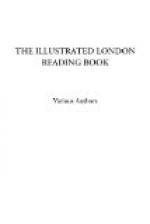[Illustration]
The feathery larch, the rowans
red,
The brambles trailing
their tangled hair;
And each is link’d to
my waking thought
By some remembrance fancy-fraught.
[Illustration]
Yet, lovely stream, unknown
to fame,
Thou hast oozed,
and flow’d, and leap’d, and run,
Ever since Time
its course begun,
Without a record, without
a name.
I ask’d the shepherd
on the hill—
He knew thee but as a common
rill;
I ask’d the farmer’s
blue-eyed daughter—
She knew thee but as a running
water;
I ask’d the boatman
on the shore
(He was never ask’d
to tell before)—
Thou wert a brook, and nothing
more.
Yet, stream, so dear to me
alone,
I prize and cherish
thee none the less
That thou flowest unseen,
unpraised, unknown,
In the unfrequented
wilderness.
Though none admire and lay
to heart
How good and beautiful thou
art,
Thy flow’rets bloom,
thy waters run,
And the free birds chaunt
thy benison.
Beauty is beauty, though unseen;
And those who
love it all their days,
Find meet reward in their
soul serene,
And the inner
voice of prayer and praise.
* * * * *
STAFFA.
[Illustration: Letter H.]
Having surveyed the various objects in Iona, we sailed for a spot no less interesting. Thousands have described it. Few, however, have seen it by torch or candle light, and in this respect we differ from most tourists. All description, however, of this far-famed wonder must be vain and fruitless. The shades of night were fast descending, and had settled on the still waves and the little group of islets, called the Treshnish Isles, when our vessel approached the celebrated Temple of the Sea. We had light enough to discern its symmetry and proportions; but the colour of the rock—a dark grey—and the minuter graces of the columns, were undistinguishable in the evening gloom. The great face of the rock is the most wonderful production of nature we ever beheld. It reminded us of the west front of York or Lincoln cathedral—a resemblance, perhaps, fanciful in all but the feelings they both excite—especially when the English minster is seen by moonlight. The highest point of Staffa at this view is about one hundred feet; in its centre is the great cave, called Fingal’s Cave, stretching up into the interior of the rock a distance of more than 200 feet. After admiring in mute astonishment the columnar proportions of the rock, regular as if chiselled by the hand of art, the passengers entered a small boat, and sailed under the arch. The boatmen had been brought from Iona, and they instantly set themselves to light some lanterns, and form torches of old ropes and tar, with which they completely illuminated the ocean hall, into which we were ushered.




